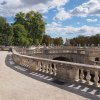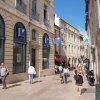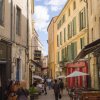The Faucher family ultimately traces its paternal roots back to the Romanesque town of Nîmes in Provence. My brother and father spent the next two days scouring the town archives for our family history, whilst Elaine and I set about exploring this historic town by foot. Of special interest to us was the Arènes de Nîmes and the Maison Carrée.
An excerpt from the Wikipedia article on Nîmes:
Nîmes became a Roman colony sometime before 28 BC, as witnessed by the earliest coins, which bear the abbreviation NEM. COL, “Colony of Nemausus”. Some years later a sanctuary and other constructions connected with the fountain were raised on the site. Nîmes was already under Roman influence, though it was Augustus who made the city the capital of Narbonne province, and gave it all its glory.
The city had an estimated population of 60,000 in the time of Augustus. Augustus gave the town a ring of ramparts six kilometres long, reinforced by fourteen towers; two gates remain today: the Porta Augusta and the Porte de France. An aqueduct was built to bring water from the hills to the north. Where this crossed the River Gard between Uzes and Remoulins, the spectacular Pont du Gard was built. This is 20 km north east of the city. Also, the Maison Carrée is one of the best preserved temples to be found anywhere in the territory of the former Roman Empire. Nothing remains of certain monuments, the existence of which is known from inscriptions or architectural fragments found in the course of excavations. It is known that the town had a civil basilica, a curia, a gymnasium and perhaps a circus. The amphitheatre dates from the end of the 2nd century AD. The family of Roman Emperor Antoninus Pius came from Nemausus.
As it happens, we arrived right in the middle of bull fight season. So the streets were crowded, vendors were setting up and the Coorida’s spirit filled the air. In modern times, bull fights and other events take place inside the original Roman Arena. Needless to say, the Romans were master engineers and architects. If the barbarians had not destroyed their buildings and monuments, many many more would be better preserved today.

The Arènes de Nîmes was built around 70 AD, it was remodeled in 1863 to serve as a bullring. The building encloses an elliptical central space 133 m long by 101 m wide. It is ringed by 34 rows of seats supported by a vaulted construction. It has a capacity of 16,300 spectators and since 1989 has a movable cover and a heating system.

Unfortunately, we could not gain entrance to the arena on account of the bullfights, as preparations were underway. Pity, as I would have loved to explored the interior. I had done it once back in 1999 and was looking forward to it anew. Also, bullfight tickets were sold out and it was only possible to obtain them from scalpers at prices approaching the eye raising levels of Toronto Maple Leaf tickets. However, the bull has a better chance of coming out a winner than the Leafs do winning a Stanley Cup.

After taking our fill of the arena, we walked to visit the Maison Carrée. The interior had been converted into a movie theatre, so there was no point to going in to see the interior. The history was covered up with vulgar modernity. Nonetheless, it was worth the visit to see this well preserved Roman building.

The Maison Carrée is one of the best preserved Roman temples to be found anywhere in the territory of the former Roman Empire. It was built c. 16 BC, and reconstructed in the following years, by Marcus Vipsanius Agrippa, who was also the original patron of the Pantheon in Rome, and was dedicated or rededicated c. 2-4/5 AD to his two sons, Gaius Caesar and Lucius Caesar, adopted heirs of Augustus who both died young.
We walked over to see Temple of Diane and went through a beautiful water park. The Temple of Diane is in ruins, but at least we had a chance to go inside and explore at will.

Hidden away among greenery, the romantic ruins of a Roman temple… or perhaps more prosaically, of a brothel. Dating from the 2C, this building used to stand near the Roman baths. Incorporated into a convent, it was destroyed in 1577 during the Wars of Religion.


A popular pass time in Nîmes is the game of Pétanque. It is similar to Bocce Ball played by Italians. Pétanque is a form of boules where the goal is, while standing inside a starting circle with both feet on the ground, to throw hollow metal balls as close as possible to a small wooden ball called a cochonnet (literally “piglet”) or jack. It is also sometimes called a bouchon (literally “cork”) or le petit (“the small one”). The game is normally played on hard dirt or gravel, but can also be played on grass, sand or other surfaces

Stay tuned for another Nîmes posting.






















